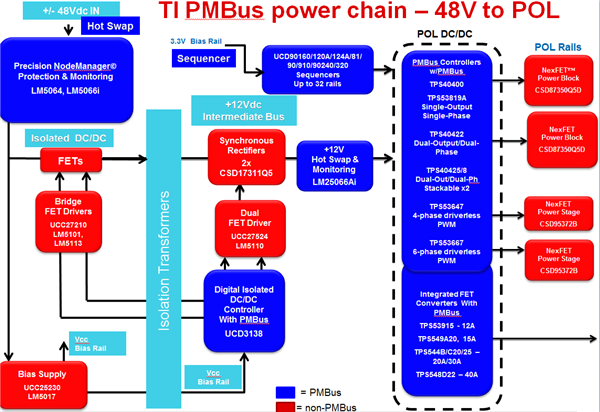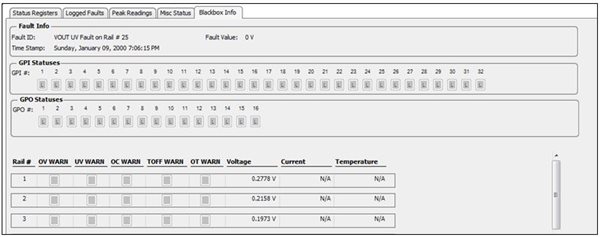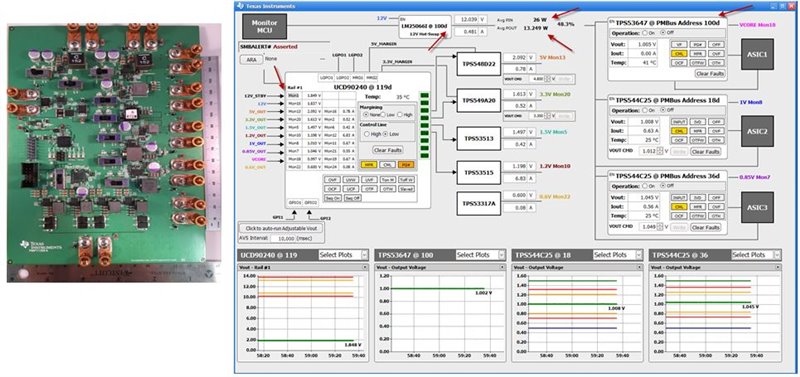SSZTAO3 november 2016 TPS53667 , UCD90240 , UCD90320
You can find hardware systems with multiple low-voltage rails that need regulation, sequencing and monitoring in cloud infrastructure equipment like base stations, networking switches, servers and storage, as well as test and measurement applications such as integrated circuit (IC) testers, oscilloscopes and network analyzers.
The Power Management Bus (PMBus) digital interface is a popular interface, which I discussed in another blog post, “A PMBus primer: common PMBus questions answered.”
TI has a complete PMBus power solution for systems using 48VDC on the front end and 12VDC or another low-voltage DC rail as the intermediate bus; see Figure 1.
 Figure 1 48V to Point-of-load PMBus
Power System
Figure 1 48V to Point-of-load PMBus
Power SystemThe benefits of a complete PMBus solution in multirail systems are many: ease of use; reduced design time (as a new design can be generated in seconds by reconfiguring the on-chip nonvolatile memory [NVM]); reduction in overall component count and total solution cost; a unified and seamless design and programming method through a single graphical user interface (GUI); much simpler board characterization through PMBus margining; and improved diagnostics through voltage, current, temperature, power and fault monitoring.
Multirail PMBus sequencers/managers such as the 24-rail UCD90240 and the new 32-rail UCD90320 can sequence, margin, monitor and report faults for up to 32 rails using TI’s Fusion Digital Power™ GUI. They can also be stacked in fours for up to 128 rails, managed through the SYNC_CLK pin if needed.
Additionally, the UCD90240 and UCD90320 have true black-box logging that provides detailed information about all rails, General Purpose Input (GPI), and General Purpose Output (GPO) status on the first fault, as shown in Figure 2.
 Figure 2 UCD90240/UCD90320 Black-box
Logging
Figure 2 UCD90240/UCD90320 Black-box
LoggingUCD90xxx PMBus sequencers/managers work with analog and PMBus point-of-load voltage regulators to provide a PMBus management and voltage-regulation solution in multirail systems, which almost always have one or more high-current application-specific integrated circuits (ASICs), processors and/or field-programmable gate arrays (FPGAs).
The loads require precise multiphase step-down conversion from the 12V intermediate bus to their respective rails. Typical load currents range from 50A to 200A, and the multiphase converter may require up to six phases to distribute power and thermals effectively and reduce the size and count of the inductor and output capacitors through phase interleaving.
One such six-phase converter is the TPS53667.
How does a multirail UCD90xxx PMBus sequencer come together with multiple PMBus voltage regulators in a design? The TI Designs PMBus Power System for Enterprise Ethernet Switches Reference Design is a good example, as shown in Figure 3.
The design employs a PMBus sequencer, a PMBus hot-swap IC (for the input current) and eight analog and PMBus voltage regulators, including a four-phase PMBus buck controller and a double-data-rate (DDR) termination (Vtt) switcher. The Fusion Digital Power GUI provides a graphical representation of the power tree and offers the capability to program the main parameters on the top half, while monitoring key parameters such as voltage, current, temperature and power on the bottom half.
If you are designing multirail systems with high-current processors, ASICs and/or FPGAs and want to simplify your design and characterization, reduce development time, and increase your system’s diagnostic capability, consider TI’s PMBus power solutions.
 Figure 3 The Reference Design’s PMBus
Board and Fusion Digital Power GUI
Figure 3 The Reference Design’s PMBus
Board and Fusion Digital Power GUIAdditional Resources
- Watch the video, “Unboxing a 24-A, 6-Phase PMBus Buck Converter Design.”
- See the digital power supply portal for more information about TI PMBus power solutions.